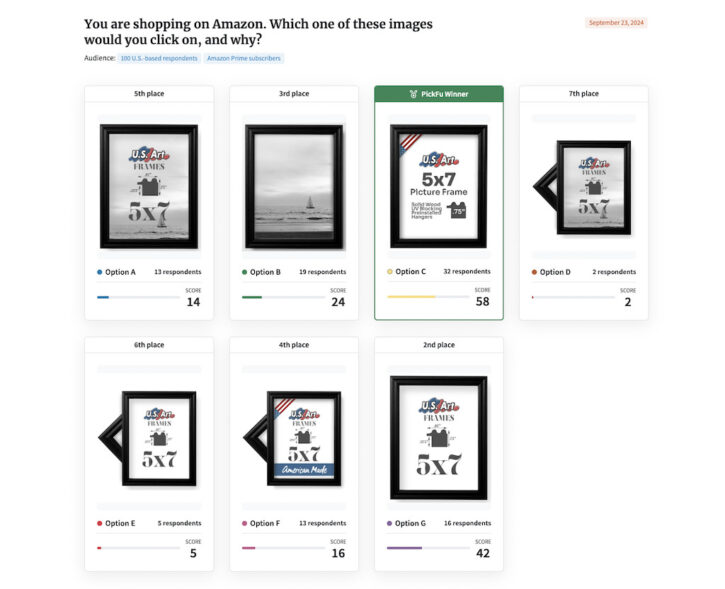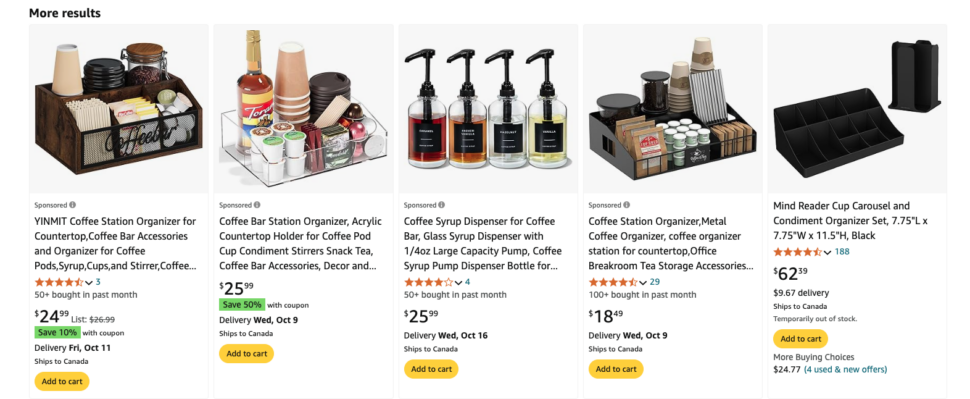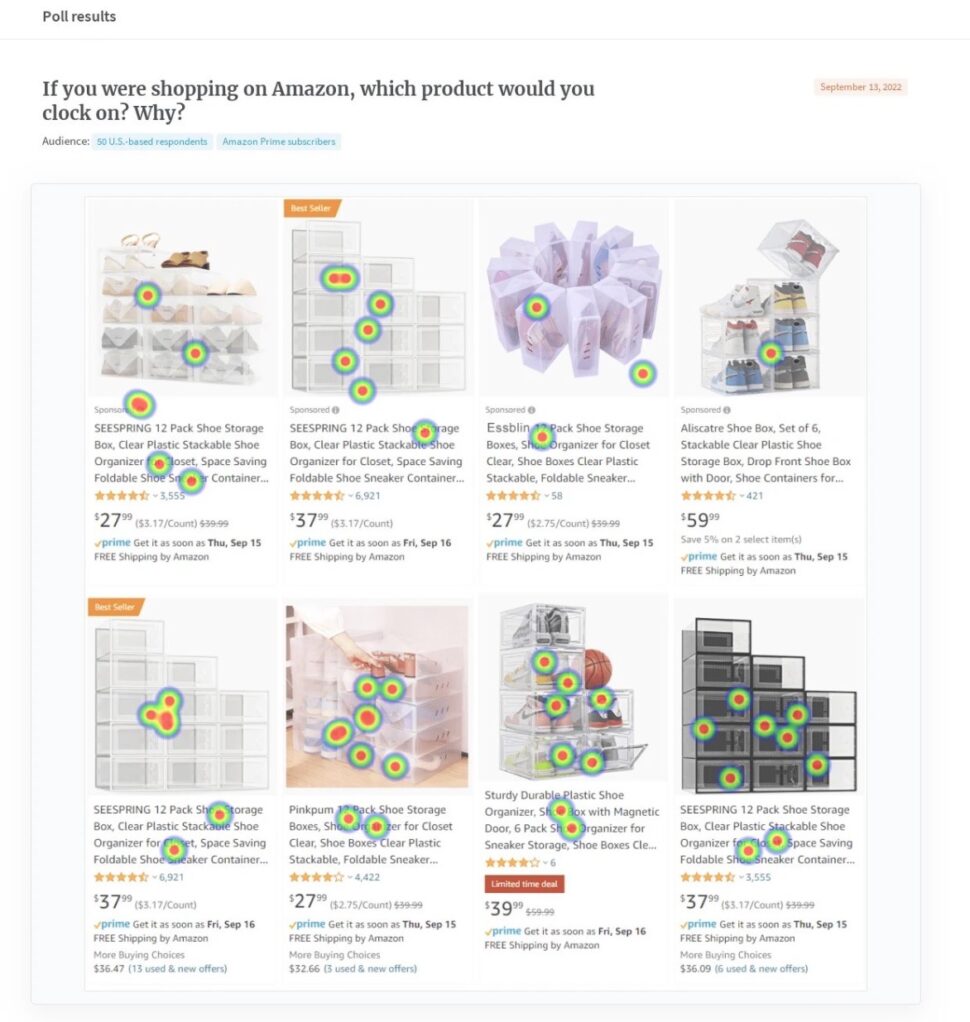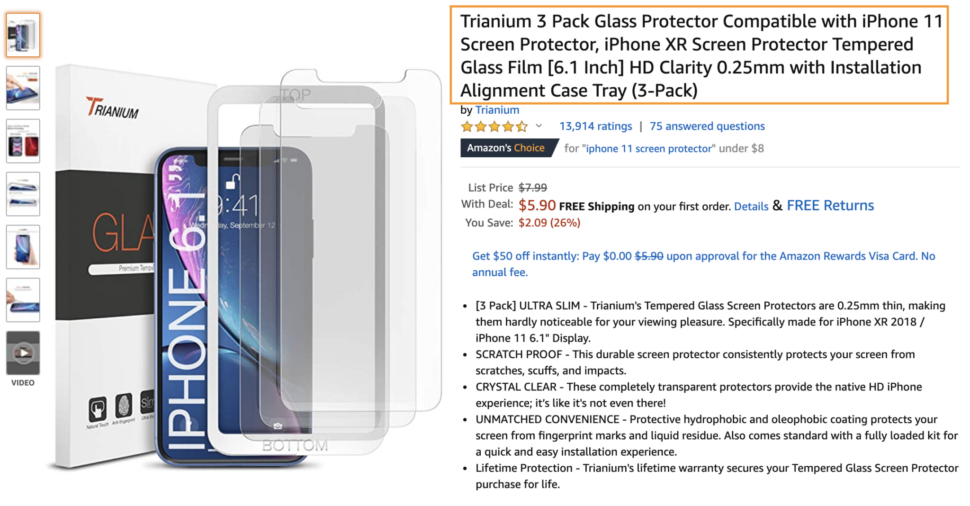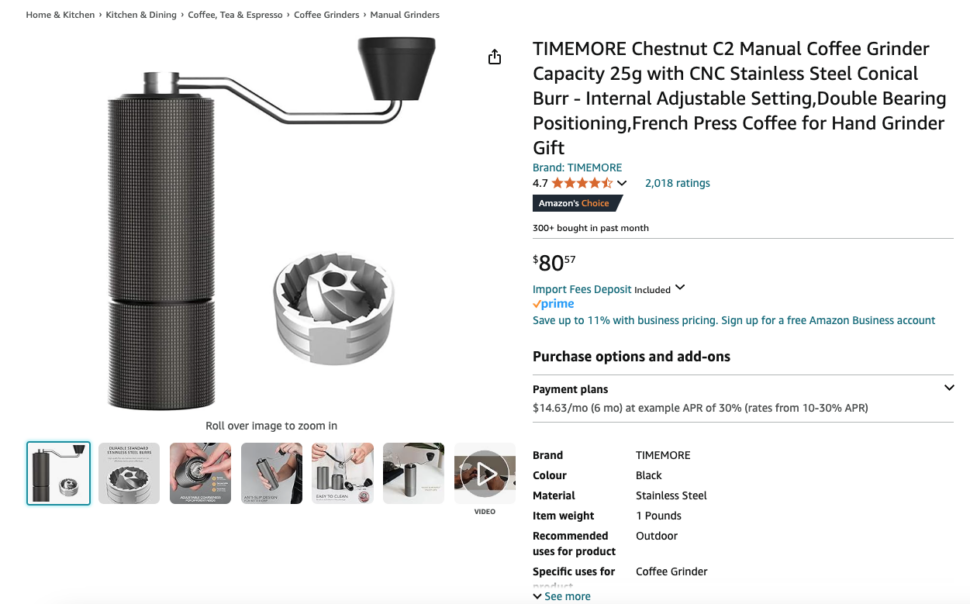Your Amazon click-through rate (CTR) is a crucial performance metric when you’re an Amazon seller. It reflects the ratio of people who see your product listing – also known as impressions – to those who click on it. A higher CTR means your product listings are attracting potential buyers.
All sorts of things can influence your Amazon CTR, but the key elements are product images, titles, descriptions, and pricing. The more appealing these components, the higher your chances of grabbing a customer’s attention.
Amazon is more competitive than ever before, which means you should be paying attention to your CTR.
We’ll show you how to improve your CTR on two separate components of your Amazon business: your CTR for ads and your CTR for product listings. Whether you’re an Amazon FBA (fulfilled by Amazon) or FBM (fulfilled by merchant) seller, you’ll come away with tools to drive clicks and conversions.
What is a good CTR on Amazon?
A good CTR for Amazon PPC campaign ads is between 0.3% and 0.5%, but for product listings, it’s 2-3% – or up to 5% if you’re really killing it.
Let’s break down what these percentages mean. For Amazon ads, the rate of 0.3 to 0.5% means that for every 1,000 times your ad is shown, 3 to 5 people click on it.
The CTR for product listings is higher – for every 1,000 people who view your product, 20-30 (or more!) people click.
Why the big difference? Because people tend to trust the organic results of their search more than the sponsored listings at the top. Organic results earn their position based on relevance and performance, not paid placement, and that’s a big plus for shoppers. Organic results usually have a higher conversion rate, too.
But ads are still important, largely because more people see your ad and realize your product exists. Ads give your brand guaranteed visibility at the top of search results – which is especially important for competitive keywords where organic ranking might be hard to get.
Basically, ads introduce more people to your product – people who otherwise wouldn’t have seen it. When you’re a newer or lesser-known brand that needs to build awareness, this is gold.
Still, you definitely can boost your low CTR to a high one for ad campaigns and product listings alike.
Boosting Amazon CTR for ads
Improving your CTR for ads is all about optimization. So what should you focus on when it comes to optimizing your ads? We suggest:
- Using relevant keywords. Like they are everywhere else, keywords are critical to the success of your Amazon advertising efforts. Use high-converting, long-tail keywords that are specific to your product. These usually face less competition—and they attract buyers who are further down the purchase funnel.
- Adding negative keywords. A negative keyword is a term or phrase that you add to your Amazon advertising campaigns to prevent your ads from showing up in search results for irrelevant or unwanted queries.
- Optimizing your product title, ad copy, and images. Your product title, images, product detail page, and ad copy need to immediately capture a shopper’s attention. Weave details about your key product features and benefits into the copy and end with a strong call-to-action (CTA).
- Including reviews. Positive reviews can significantly influence a shopper’s decision to click. Highlight your product’s best features, customer reviews, and key benefits in your ad copy to build trust with potential customers.
- Experiment with product pricing and promotions. Amazon shoppers are there for the good prices, so optimizing your pricing strategy can increase CTR. Try running time-limited promotions, discounts, or bundling offers to grab attention. Using a competitive price point in your ad can create urgency and compel shoppers to click.
By now, you might be wondering how to know whether your product title will grab a shopper’s attention. Or which reviews to use in your ads. Or what price point or promotion will get people on the fence to jump into your side of the field.
PickFu it.
All of it.
With PickFu, you can reach a built-in audience of people who fit your target customer profile. Ask them a question and they’ll give you votes and written feedback. Your PickFu respondent pool can help you choose the best images to use from a product photography session. Or which promotion would make them hit the shop now button on a pay-per-click ad.
Whether you need to run A/B testing or ask your target audience to rate a display ad from 1 to 5 stars, PickFu makes Amazon PPC optimization quick and easy.
And since you know your assets are going out into the world optimized to the nth degree, you’ll rest easy knowing your ad spend won’t go down the drain.
Driving Amazon CTR for product listings
Organic listings have a higher CTR than ads, and the sky’s really the limit with how much you can drive your CTR upwards. Remember, 2 to 3% is a good CTR, but you can go up to 5%. Maybe even 6%, or 7%.
Driving your CTR up for ecommerce product listings is pretty straightforward. From product titles to Amazon A+ Content, here’s how to optimize the elements of your Amazon product listing for a good click-through rate.
Product title
Everything starts with crafting a compelling product title for your listing. This is the first thing your shoppers will see, and it needs to immediately deliver the most important info about your product. At the same time, it shouldn’t be so wordy or stuffed with keywords that you put shoppers off with the clutter.
Highlight the most important features and benefits of your product, like size, color, material, and brand.
A strong title for a kitchen blender might be: “Trianium 3 Pack Glass Protector Compatible with iPhone 11 Screen Protector.” A short but informative title like this helps your product stand out – and attract more clicks.
Images
Next, you’ll want to optimize your Amazon image stack.
High-quality product images are one of the biggest factors in improving CTR.
Amazon allows up to nine images per listing, with seven of those (six if you include a video) shown on your live listing.
Make the most of them! Pick the best one to be your main image. Show your product from different angles. Highlight key features. Include lifestyle images that show how customers can use the product. Include a video. Create a compelling Amazon infographic. PickFu is your best friend here because you can ask your target audience if the images would get them to click on your Amazon listing – including which one should be the main image. (Note: Curious on how PickFu can help with amazon main image optimization? Check out our related article!)
In a recent poll, a PickFu user asked a group of 100 Amazon Prime members which product image they’d click on and why.
Respondents ranked the seven choices in order of best to worst. The images are all pretty similar, with variations mostly in the text on the frame insert, the color of the insert, and whether there was a frame corner poking out of the side to showcase… something?
Anyway, Option C won. Here’s what PickFu’s Amazon Prime subscribers had to say:
- “[Option] C tells me all needed info about the frame at a simple glance.”
- “Options C, G, F and E seem bright and fresh. I prefer Option C because it’s easiest to see the shape of the frame. Options A and D seem a bit dingy.”
- “I like the basic look of [Option C]. I don’t need artwork because I will be taking it out anyway, the product information is the most important to me.”
- “I would click on this image, Option C, because I feel that it gives the most information about the product in the picture and is a very clear picture of what the product looks like. I also like how it gives the total dimensions of the preinstalled hanger inside the visual of the hanger on the product.”
In short, respondents liked that Option C is easy to see and read, and that it provides all the information they need to make a decision to click.
Product descriptions
We’ve all seen those product descriptions that look like they were written by a 4th-grader. Or the ones copy-pasted straight out of ChatGPT. And look – we’re all about using AI to help you generate ideas, create outlines, and gather information into a written format.
But AI doesn’t have a creative brain like you do, and it’s this creativity and engaging style that’ll grab shoppers’ attention. So whether you write your product description from scratch or use AI to help guide you, make sure it’s:
- Easy to read. No indigestible blocks of text or run-on paragraphs, please. If you’re selling a coffee maker, speak to its ease of use and unbeatable flavor: Get the most flavor out of your coffee beans with our built-in grinder. Our machine delivers fresh coffee into your cup at the touch of a button. Sip fresh, hot coffee every morning–no cleanup necessary. No, really.
- Visually appealing. Bullet points are your friend. They make details like dimensions, materials, compatibility, and special features easier to spot. Use all caps font for the part of a bullet point that goes before the colon to make reading it even easier, like this:
- SELF-CLEANING: No messy coffee grounds to deal with. Just press a button, let the grounds empty into one of our compostable bags, and stick the whole thing in your compost bin when the “full” light turns on.
- AI-POWERED BREWING: Say the magic words—“brew a cup of coffee, please”—and your coffeemaker will grind and brew the perfect cup in less than 2 minutes.
- SMALL PROFILE: Our coffee maker is short enough to fit under your cabinets and slim enough to squeeze between your other appliances.
- Customer-focused. Don’t talk about how cool your product is. Talk about what your product can do for your customer. Tap into your creative side here. Use descriptive, immersive language to show your customer how the product will help them.
- Mornings are hard. Our coffeemaker makes them easier. Enjoy a freshly ground and brewed cuppa in less than 2 minutes, no cleanup necessary.
- Focused on pain points. You should be well-acquainted with your audience’s pain points and needs. Make sure you speak to those in your product description. If your audience craves durability, highlight how long the product will serve your customer. If they’re more concerned about sustainability, stress how your product helps buyers reduce their carbon footprint.
- Our composting cleanup system means your coffee habit gives back to the planet.
- SEO-friendly. The Amazon algorithm scans each listing for keywords that match customer search terms. Do keyword research with some of the best seller tools like Ahrefs or Semrush to find relevant phrases to weave into the copy. For “coffee machine,” these are some of the keywords Ahrefs delivers:
- bean to cup coffee machine
- best home coffee machine
- best coffee machine
- coffee machine with grinder
- best eco friendly coffee machine
Finish with a strong CTA and you’re well on your way to an engaging product description. If you need help knowing whether it’s any good, PickFu it! Our respondents will give you the candid responses you need to tweak and edit your content.
Customer reviews and ratings
Social proof is a powerful tool to take you from average CTR to high CTR. Amazon reviews and ratings tell other shoppers whether to trust you and your product, so making sure you get good ones is crucial.
But you don’t have to have only 5-star reviews.
That looks more suspicious than genuine because you’re never going to have 100% of shoppers love every product you put out. Nobody will.
But if you’ve got at least a four-star average with lots of positive reviews, you’re in a good spot. Anything higher than four stars is even better.
The only way to improve CTR with reviews and ratings is to:
- Poll people on specific concepts to see if they’d like them, which can help you create product delighters—aka, features that make customers swoon with excitement (psst, PickFu can help with this!)
- Create and deliver an excellent product
- Ask satisfied customers to leave reviews
- Quickly address negative feedback and make things right for customers
That’s all there is to it.
Pricing
Pricing is key to getting people to click on a listing and purchase your product. Hitting the sweet spot can be tough – you want the price to appeal to buyers yet allow you to be profitable. (Our guide to pricing sensitivity can help you figure it out!)
If your product is way more expensive than all the other listings a shopper is looking at, you probably won’t get that coveted click. If it’s way lower, you might get more clicks but hurt your bottom line.
Use PickFu to help you establish the best price range for your product by running a price sensitivity poll.
Then, use Amazon’s dynamic pricing tools to automatically adjust your prices based on market trends, competitor pricing, and fluctuations in demand. You can also try offering limited-time promos to create urgency – “Save 30% Today Only,” for example.
Amazon A+ Content
If you’re a brand-registered seller, you can use Amazon A+ Content – also known as Enhanced Brand Content, or EBC – to attract customers. This includes things like written copy, EBC images, and EBC design, and you can test all of it with PickFu.
It’s basically a sleeker version of the “regular” FBA tools Amazon sellers have at their disposal: high-quality images, videos, comparison charts, and detailed product descriptions.
Use PickFu to help you get a higher click rate
PickFu can help lower your FBA startup costs by making sure your Amazon PPC ads and product listings are optimized before launch. Whether you’re looking to make passive income with Kindle or audiobooks or want to throw yourself into a global Amazon expansion strategy for your FBA business, PickFu delivers the feedback you need to succeed.
You can even ask PickFu respondents to visit your Amazon listing and tell you what question they have, or what areas they’d like to see improved. That’s what this user did in a recent poll.
The user’s target audience generally approved of the listing, but they had several hangups:
- “The price [is] too much for anyone to buy [as] it’s a niche item.”
- “It would benefit this product greatly if a different color option was offered. Perhaps one white or off-white, or even stainless steel. This way, you can have the canister appeal to homeowners with many different kitchen types.”
- “I’m bad at estimating volume and size. Would this be big enough to hold a standard bag of Starbucks coffee beans?”
- “It does a good job explaining the benefits and showing good informative pictures as well. If I needed one I might consider this one but it has a low amount of reviews so I would have to research it outside of Amazon.”
- “Does this work for ground coffee beans too or just whole beans? I think the product is great. Does it really extend freshness?”
- “I wonder how this compares to traditional holding of coffee beans and how much longer it says fresh.”
So many good questions here, and they’re all questions that are hard to imagine yourself if you’re the one selling a product. The customer perspective is essential to building a powerhouse of a listing – and PickFu’s here to put you in your customers’ shoes.
It won’t be long until you see your spot on the search results page move up to the top.
Sign up for free and start Amazon split testing with PickFu today.
FAQs
What is a good CTR?
A good CTR on Amazon varies depending on the product category and whether you’re looking at ads or organic listings. For Amazon PPC ads, a good CTR is typically between 0.3% and 0.5%, though higher is better, especially in competitive categories. For organic listings, a good CTR usually falls between 2% and 3%, with top-performing listings reaching 5% or more. Achieving a high CTR means your listing or ad is resonating well with shoppers and encouraging them to click.
Why does your Amazon CTR matter?
Your Amazon CTR matters because it directly affects your product’s visibility and sales potential. A higher CTR indicates that your listing or ad is attracting attention, which can lead to better search rankings and more traffic. For ads, a strong CTR can also lower your advertising costs, including ACOS (advertising cost of sales), and improve ad position.
How do I calculate CTR on Amazon Sponsored Products?
To calculate CTR on Amazon Sponsored Products, divide the number of clicks your ad receives by the number of impressions (how many times your ad was shown). Then, multiply that result by 100 to get the percentage. For example, if your ad had 1,000 impressions and 10 clicks, your CTR would be 1%. This metric helps you understand how effective your ad is at attracting shopper attention and helps you determine ad placement for sponsored brands.
